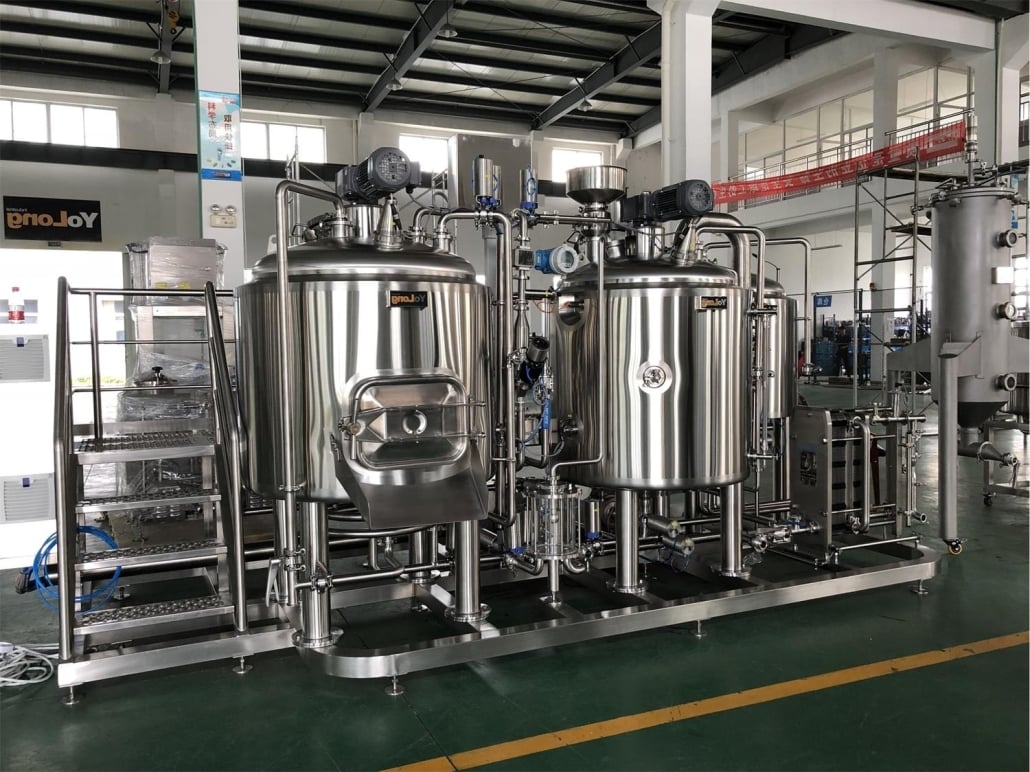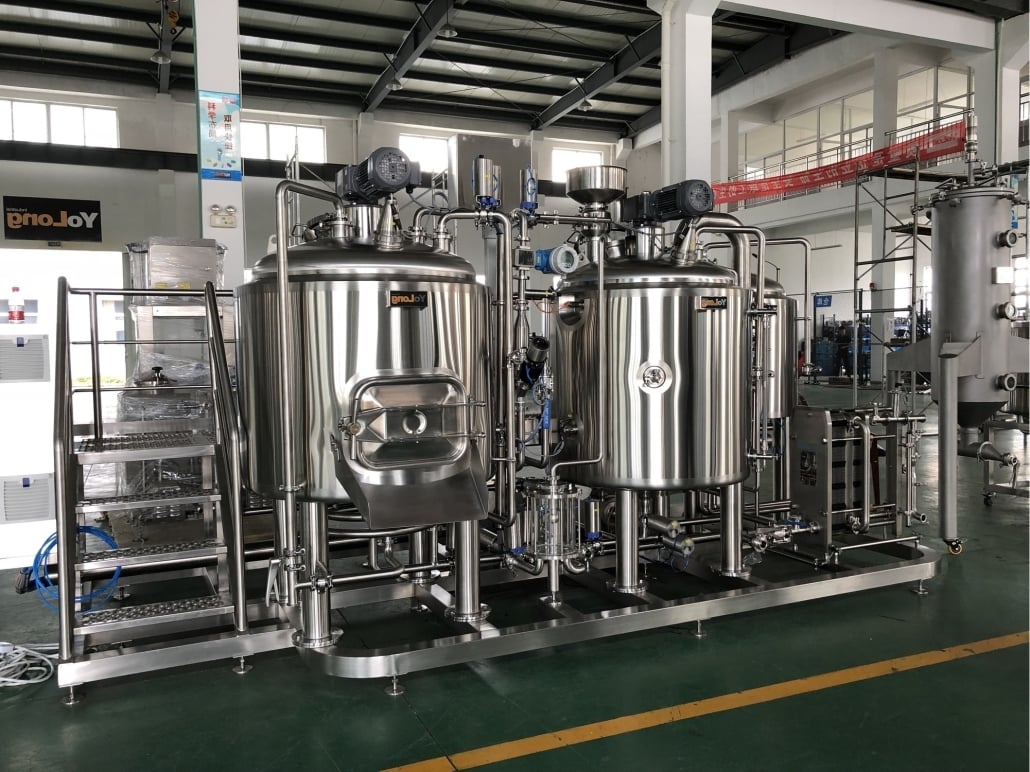Different Types of Stainless Steel Fermentation Tanks
The heart of any fermentation process, from brewing your favorite craft beer to cultivating kombucha for a gut health boost, lies in the fermentation tank. While various materials can be used for these vessels, stainless steel reigns supreme due to its impeccable durability, sanitation ease, and temperature control capabilities. But within the realm of stainless steel fermenters, a diverse landscape of options awaits, each catering to specific fermentation needs and preferences.
This comprehensive guide delves into the intricacies of different types of stainless steel fermentation tanks, equipping you with the knowledge to select the perfect vessel for your unique fermentation journey. Buckle up, fermentation enthusiasts, as we embark on a deep dive into the world of these essential tools!

Explanation of Cylindrical Fermenters: The Workhorses of Fermentation
Imagine a robust, upright cylinder, crafted from gleaming stainless steel. This, my friends, is a quintessential cylindrical fermenter, often referred to as a horizontal fermenter due to its positioning. These workhorses of the fermentation world are renowned for their versatility and ease of use, making them a popular choice for both homebrewers and large-scale producers.
Key characteristics of cylindrical fermenters:
- Simple design: Featuring a cylindrical body with a flat top and bottom, these tanks offer unmatched simplicity in both construction and operation.
- Space-saving: Their compact footprint makes them ideal for maximizing production capacity in space-constrained environments.
- Cost-effective: Compared to other tank designs, cylindrical fermenters are generally more affordable due to their simpler construction.
- Mixing options: While some cylindrical tanks come equipped with internal mixing mechanisms, others rely on external pumps for agitation, offering you flexibility in mixing strategies.
Applications:
Cylindrical fermenters excel in diverse fermentation processes, including:
- Beer brewing: From ales and lagers to stouts and sours, cylindrical tanks are versatile workhorses for various beer styles.
- Winemaking: These tanks are suitable for fermenting various grape varieties and can also be used for secondary fermentation of sparkling wines.
- Cider production: The simple design of cylindrical tanks makes them well-suited for fermenting apple juice into delicious cider.
- Kombucha brewing: These tanks offer a clean and controlled environment for cultivating your favorite kombucha flavors.
However, cylindrical fermenters have their limitations:
- Sediment collection: The flat bottom can make it challenging to remove sediment efficiently, especially for processes with significant yeast or hop trub.
- Limited headspace management: Cylindrical tanks offer less control over headspace management compared to conical fermenters, which can be crucial for certain fermentation styles.
Explanation of Conical Fermenters: Designed for Efficient Sediment Removal
Picture a sleek cone standing tall on its pointed end, crafted from the same sturdy stainless steel. This is the essence of a conical fermenter, readily recognizable by its sloping sides that converge towards a cone-shaped bottom. This design isn’t just for aesthetics; it boasts functional advantages that make conical fermenters a popular choice for brewers and producers seeking optimal efficiency.
Key characteristics of conical fermenters:
- Efficient sediment removal: The sloping design facilitates the natural settling of sediment towards the conical bottom, allowing for easier removal during the fermentation process.
- Improved headspace management: The reduced headspace at the top of the cone minimizes exposure to oxygen, which can be detrimental to certain fermentation styles.
- Multiple ports: Conical tanks often come equipped with additional ports for sampling, dry hopping, and temperature control probes, offering greater operational flexibility.
Applications:
Conical fermenters are particularly well-suited for:
- Beer brewing: They are ideal for styles that produce significant sediment, such as lagers, pilsners, and IPAs, where efficient sediment removal is crucial.
- Winemaking: These tanks are used for primary and secondary fermentation of various wine styles, including red wines that benefit from sediment removal.
- Cider production: The conical design allows for easier separation of sediment from the finished cider.
While conical fermenters offer distinct advantages, they come with some considerations:
- Higher cost: Compared to cylindrical tanks, conical fermenters are generally more expensive due to their more complex design.
- Larger footprint: The sloping sides of conical tanks result in a larger footprint compared to cylindrical tanks of the same capacity, which can be a factor in space-constrained environments.
Explanation of Unitanks: The All-in-One Powerhouses
Imagine a single stainless steel vessel that combines the functionalities of multiple fermentation tanks, acting as a fermentation, conditioning, and serving vessel all rolled into one. This innovative concept is embodied in unitanks, also known as brite tanks or combi tanks.
Key characteristics of unitanks:
- Multifunctionality: Unitanks eliminate the need for separate fermentation and conditioning tanks, streamlining the process and reducing equipment costs.
- Space-saving: Their compact design makes them ideal for maximizing production capacity in limited spaces.
- Carbonation control: Unitanks are equipped with carbonation stones for precise control of carbon dioxide levels, crucial for carbonated beverages like beer and cider.
- Serving functionality: Some unitanks feature built-in serving features like carb lines and taps, allowing for direct serving from the tank without transferring the beverage.
Applications:
Unitanks are particularly well-suited for:
- Craft breweries: They offer a space-saving and cost-effective solution for breweries with limited space or resources.
- Cider production: The carbonation control feature makes unitanks ideal for producing sparkling cider.
- Kombucha brewing: These tanks can be used for fermentation, carbonation, and even serving kombucha on tap.
However, unitanks come with some limitations:
- Limited versatility: Compared to dedicated fermentation and conditioning tanks, unitanks offer less flexibility in terms of independent process control.
- Cleaning challenges: The multifunctionality can pose cleaning challenges as residual product from one stage can contaminate the next.
- Higher maintenance: The additional features of unitanks can require more maintenance and potential repairs compared to simpler tank designs.
Choosing the Right Stainless Steel Fermentation Tank: A Decision-Making Guide
Selecting the ideal stainless steel fermentation tank for your needs depends on various factors, including:
- Type of fermentation: Different fermentation processes have varying needs. Consider the sediment production and headspace management requirements of your specific product.
- Production volume: Choose a tank size that accommodates your desired batch size while leaving enough headspace for fermentation.
- Budget: Stainless steel tanks come in a range of prices. Compare costs of different options while considering your long-term needs.
- Available space: Measure your available space and ensure the chosen tank’s footprint fits comfortably.
- Desired features: Consider if you require additional features like built-in cooling jackets, carbonation stones, or serving functionalities.
Remember, there’s no one-size-fits-all solution. By carefully evaluating your needs and preferences, you can select the perfect stainless steel fermentation tank to elevate your fermentation journey and unlock the full potential of your craft.

FAQs
Q: What is the most common type of stainless steel fermentation tank?
A: Cylindrical fermenters are the most widely used due to their simplicity, affordability, and versatility.
Q: Are conical fermenters better than cylindrical ones?
A: It depends on your needs. Conical tanks offer efficient sediment removal and headspace management but come at a higher cost and require more space.
Q: Can I use a unitank for all fermentation stages?
A: While unitanks offer multifunctionality, they may not be suitable for all processes. Consider the potential limitations in terms of flexibility and cleaning compared to dedicated tanks.
Q: What are the benefits of using stainless steel for fermentation tanks?
A: Stainless steel is a popular choice due to its durability, ease of cleaning, sanitation properties, and temperature control capabilities.
Q: How do I clean a stainless steel fermentation tank?
A: Proper cleaning procedures are crucial to prevent contamination. Consult manufacturer instructions for specific cleaning protocols and recommended cleaning solutions.
Additional FAQs About Stainless Steel Fermentation Tanks
1) Which stainless grade is best for fermentation tanks: 304 or 316L?
- 304 suits most beer/cider applications. Choose 316L for higher chloride environments (sours, wine, kombucha acids, CIP with chlorides) to reduce pitting risk. Verify mill certs and weld filler match.
2) Do I need electropolished interiors for my tanks?
- Not mandatory, but electropolishing lowers Ra, improves cleanability, and reduces biofilm risk—especially valuable for unitanks and tanks used for mixed cultures or low-oxygen targets.
3) What pressure rating should I specify for unitanks?
- For modern cellar practices, target ≥2 bar (29 psi) MAWP with PRV and burst disk. This enables spunding, closed transfers, and in-tank carbonation while meeting safety codes.
4) How do jacket design and insulation impact temperature control?
- Look for dimple jackets sized for adequate surface area and multi-zone control on larger tanks; polyurethane or equivalent insulation ≥50–100 mm improves stability and cuts glycol load.
5) How should I validate cleanability after installation or repairs?
- Perform riboflavin spray coverage tests for CIP, verify surface roughness (Ra) where critical, and document passivation per ASTM A967. Add swab/ATP checks until baseline confidence is achieved.
2025 Industry Trends for Stainless Steel Fermentation Tanks
- Pressure-capable unitanks standard: 2–3 bar MAWP is becoming default across micro and regional breweries.
- Hygiene by design: Electropolished internals, shadowless spray balls, and validated CIP coverage are increasingly specified.
- Smarter cellars: Inline DO/CO2 and turbidity ports with OPC UA connectivity to SCADA/cloud dashboards.
- Sustainability: Better insulation, jacket efficiency, and heat/cold integration reduce energy use; citric-based passivation favored for safer maintenance.
- Lead-time normalization: Delivery windows improving versus 2021–2023; customization and premium finishes still extend timelines.
2025 Data Snapshot: Adoption and Specifications
| Metric | 2022 | 2024 | 2025 (proj.) | Notes / Sources |
|---|---|---|---|---|
| New unitanks with ≥2 bar rating | 38% | 50% | 58–62% | Supplier catalogs; trade press |
| Electropolished interior uptake | 16% | 23% | 28–33% | Fabricator reports; QA case studies |
| Tanks specified with inline QA ports (DO/CO2) | 24% | 34% | ~40% | Instrument vendors; BA Quality sessions |
| Avg. lead time, 10–40 hL CCTs (weeks) | 18–24 | 12–18 | 10–16 | BA supplier briefings; vendor surveys |
| CO2 purchase reduction via spunding | — | 25–35% | 30–45% | IBD talks; brewery case notes |
Sources:
- Brewers Association: https://www.brewersassociation.org
- Institute of Brewing & Distilling (IBD): https://ibd.org.uk
- ASTM A967 Passivation: https://www.astm.org/a0967_a0967m-17.html
- AMPP (corrosion resources): https://www.ampp.org
Latest Research Cases
Case Study 1: Electropolished Unitanks Improve CIP Efficiency (2025)
Background: A craft brewery struggled with long CIP cycles and occasional ATP swab failures on legacy 304 tanks (mechanically polished only).
Solution: Installed 316L unitanks with electropolished interiors, shadowless rotary spray balls; standardized auto-CIP with conductivity and temperature verification; riboflavin coverage validation.
Results: CIP time cut 15–20%; caustic usage down 10–15%; ATP pass rate >99% across 6 months; fewer flavor stability complaints. Sources: Brewers Association Quality seminars; OEM application notes.
Case Study 2: Pressure Fermentation in 2-bar CCTs Reduces Oxygen Pickup (2024/2025)
Background: A regional brewery packaging hop-forward beers saw variable TPO and CO2 costs.
Solution: Adopted 2-bar MAWP unitanks, spunded at 1.0–1.3 bar, implemented closed dry-hop loop and closed transfers; added inline CO2 and DO measurement at brite.
Results: Purchased CO2 reduced ~35–45%; package TPO down 25–30%; ale tank turns improved ~15–20%. Sources: IBD technical talks; tank/instrument vendor briefs.
Expert Opinions
- Charlie Bamforth, Distinguished Professor Emeritus of Malting & Brewing Science, UC Davis
Viewpoint: “Cleanability and oxygen control dominate beer stability. Stainless steel fermentation tanks with validated CIP and smooth finishes are non-negotiable.” - John Palmer, Author of “How to Brew” and brewing consultant
Viewpoint: “Pressure-capable unitanks and reliable temperature control provide the biggest quality ROI before more complex automation.” - Katherine C. Smart, Professor of Brewing Science; Former Global VP R&D, AB InBev
Viewpoint: “Linking inline QA and automated CIP turns fermentation vessels into controlled systems, lowering variability and losses.”
Citations:
- UC Davis CPE brewing resources: https://cpe.ucdavis.edu
- Brewers Association Quality: https://www.brewersassociation.org
- IBD resources: https://ibd.org.uk
Practical Tools and Resources
- ProBrewer tank sizing and forums: https://www.probrewer.com
- G&D Chillers load calculator (cellar sizing): https://gdchillers.com
- Anton Paar inline DO/CO2/turbidity/density instruments: https://www.anton-paar.com
- ASTM A967 Passivation standard: https://www.astm.org/a0967_a0967m-17.html
- AMPP corrosion control for stainless: https://www.ampp.org
Note: When specifying stainless steel fermentation tanks, confirm material grade and certs (304 vs 316L), MAWP and safety devices (PRV, burst disk), internal finish (Ra/electropolish), jacket surface area and insulation thickness, CIP spray coverage validation, and ports for closed transfers and instrumentation. Align with local code for pressure vessels and sanitary design.
Last updated: 2025-09-02
Changelog: Added 5 targeted FAQs, 2025 trend snapshot with data table, two recent case studies, expert viewpoints, and curated tools/resources focused on stainless steel fermentation tanks.
Next review date & triggers: 2026-01-15 or earlier if tank lead times shift >20%, new BA/IBD guidance on CIP/oxygen control is released, or ASTM/AMPP standards are updated.
Share this entry
Interested in learning more about Brewing Systems including additional details and pricing information? Please use the form below to contact us!
YOLONG BREWERY EQUIPMENT FAQS
- Commercial Brewery / Craft Brewery / Microbrewery / Nanobrewery
- What is The Difference Between Craft Beer and Industrial Beer?
- The Bespoke Differences In Custom Brewing Systems
- Everything You Need to Know About Kettle Souring
- How to Choose Brewing Equipment for Your business?
- How To Choose The-Best Partner To Build Your Commercial Microbrewing System?
- Two Detection Sensors That You Need To Use In Your Brewhouse System
- Remote Control Applications in Brewing Equipment/How does it work?
- How To Clean Your Brand New Brewery Tanks?

